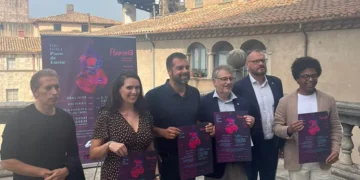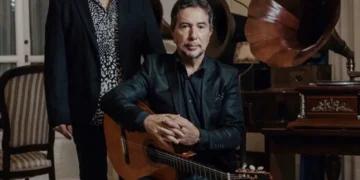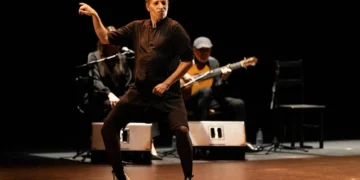
16th FESTIVAL DE JEREZ Israel Galván “La Curva” |
|
Text: Estela Zatania FLAMENCO GEOMETRY LESSON WITH TWELVE STRINGS AND A CURVE The fourth day of the Festival de Jerez got underway with the series “Vivencias”, and an engaging interview with dancer Luisa Triana at the Centro Andaluz de Flamenco. She explained how she fled the beginning of the Spanish Civil War with her father, the legendary Antonio de Triana, partner and choreographer of Carmen Amaya. Such famous names as Manuel de Falla, Pilar López, Argentinita, Luis Buñuel and John Wayne among many others, punctuated the anecdotes of this veteran dancer, now painter. ALFREDO LAGOS, DANI DE MORÓN “Doce cuerdas” Just down the block at the Sala Compañía, Alfredo Lagos and Dani de Morón offered their joint guitar recital “12 Cuerdas”. The title seems to suggest a program of guitar duets, but in actual fact it is two independent mini recitals, with a brief collaboration at the end to accompany guest dancer Ángeles Gabaldón. The young man from Morón opened, and the first vibrations of his guitar filled the space with a beautiful, round, irresistible sound. A long free-form prelude melts into bulerías, the all-purpose compás that has always been so important in Morón flamenco. Sounds of taranta with a long tremolo and strong thumb also morph into bulerías, the form that both shelters and consumes all things. Siguiriyas taken at a clip with interesting harmony that manages to avoid altering the nature of this form, and bulerías “por arriba” to close. Alfredo Lagos is only ten years older than Dani, but flamenco guitar has evolved so quickly since Paco de Lucía, that his playing belongs to another generation. Much admired and always in demand as accompanist of cante and dance, he is also an able solo player. His compositions are more musical and contemplative, less aggressive that those of his partner; opposing concepts that complement each other. A lovely rondeña, soleá with well-defined compás…he complains his hands are frozen, but then interprets some first-class bulerías at top speed with no apparent problem. The recital ends with the bulerías dance of Gabaldón, and it never occurred to anyone to have done some cantiñas, bulerías in minor key, something “ida y vuelta”, anything that would have made a welcome rest from the insistent phrygian or flamenco scale. ISRAEL GALVÁN “La Curva” Video Dance, original idea, choreography and music director: Israel Galván. Piano: Sylvie Courvoisier. Cante: Inés Bacán. Compás: Bobote. Less than six weeks ago at the Festival de Nimes, I saw Israel Galván’s most recent work, “La Curva”. It’s interesting to take note of the changes that have taken place, and the positive effect they’ve had. Specifically, the work has a more relaxed feeling, not so cold, and there are more references to compás, the glue that makes for the efficient flow of flamenco traffic. Because contrary to what some people think, “flamenco” is not in a kind of movement, nor is it footwork, nor hand-claps, polkadots, grimaces or specific accessories. It’s all of that and none of that, and one of the most constant elements is compás. But Israel Galván has little interest in such musings, because geniuses have a permanent artistic license that allows them to commit any “crime” and come out on top. And so we see the incorrigible dancer move in and out of compás the way the rest of us get on and off a bus, without losing the thread of his intent. In all of Israel’s work, you sense the subtext of a small child who really wants to do the right thing, but demands to know why he has to do what he was taught. And the question looms: does one prefer to see a second-rate artist doing flamenco, or a genius doing anything he pleases? I’m just putting the question on the table, because there is no definitive answer. Israel has the gift of non-stop self-invention, clarity of thought, and speed in the execution, all made possible by his impeccable technique. He dances martinete and tonás atop a table (is there any greater flamenco cliché than dancing on a table?…Israel recycles outdated possibilities), and he projects like the great Antonio filmed sixty years ago in the Tajo of Ronda. He amuses himself and us investigating dissonances and contradictions. Singer Inés Bacán, seated at a table, slaps her hand on the surface as if to mark compás as she sings siguiriyas…more digestible are the nanas she interprets to open the “talcum suite”. I can’t think of any other way to describe the last half hour of the work when Galván rolls around repeatedly in a large pile of what appears to be talcum powder, as if he were bathing and purifying himself, raising great white clouds that are visually fascinating, a sort of animated prop in harmony with his dancing. Many members of the audience enjoyed the contemporary experimental piano music of Sylvie Courvoisier (there is no guitar), but for those people mainly interested in flamenco, it’s difficult downtime. You have to go to see La Curva prepared to view an existential theater experience that reflects the natural incoherence of life, and of course, the genius of one of the most daring creators in the history of Spanish dance. |
Descubre más desde Revista DeFlamenco.com
Suscríbete y recibe las últimas entradas en tu correo electrónico.



























